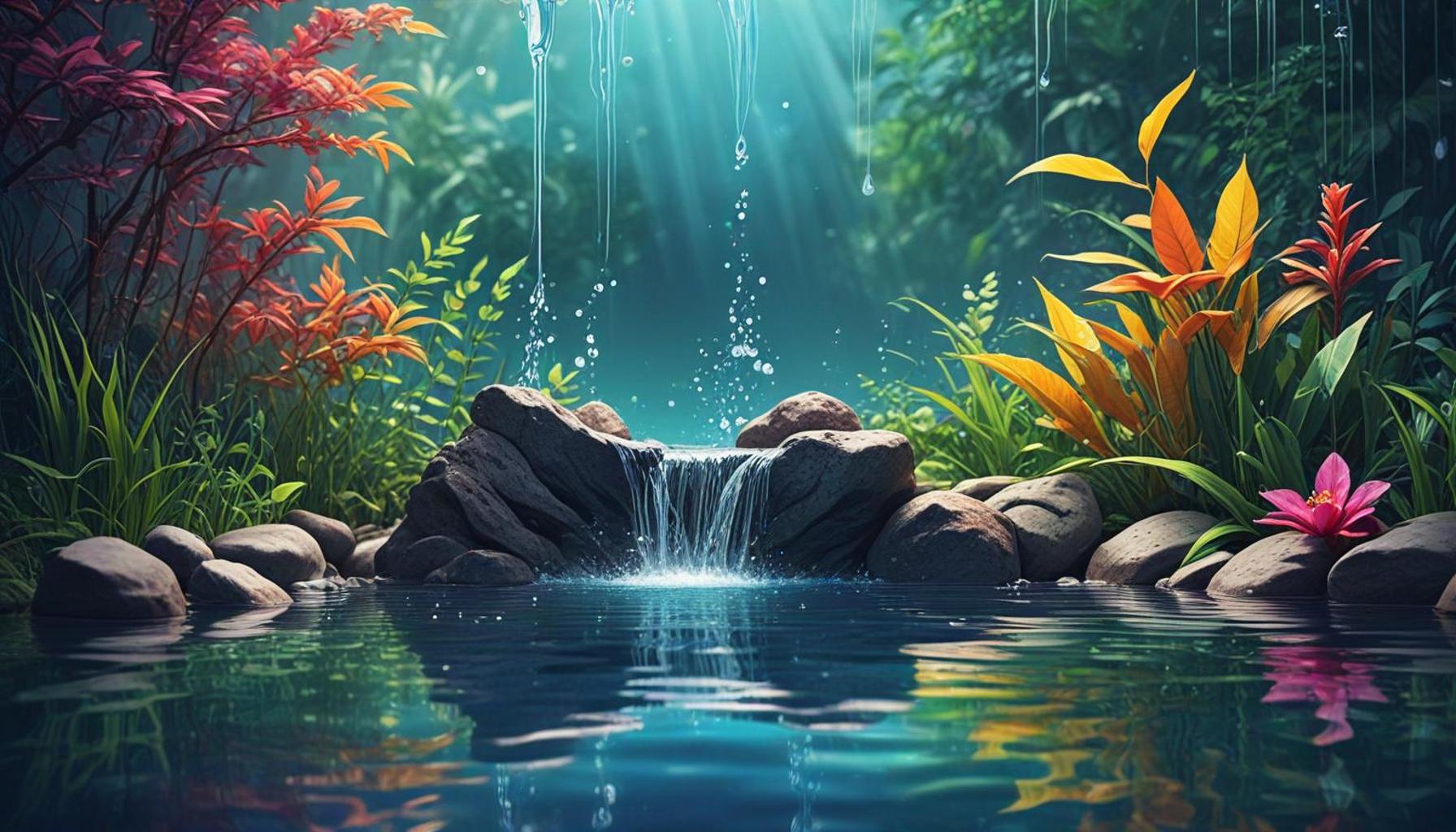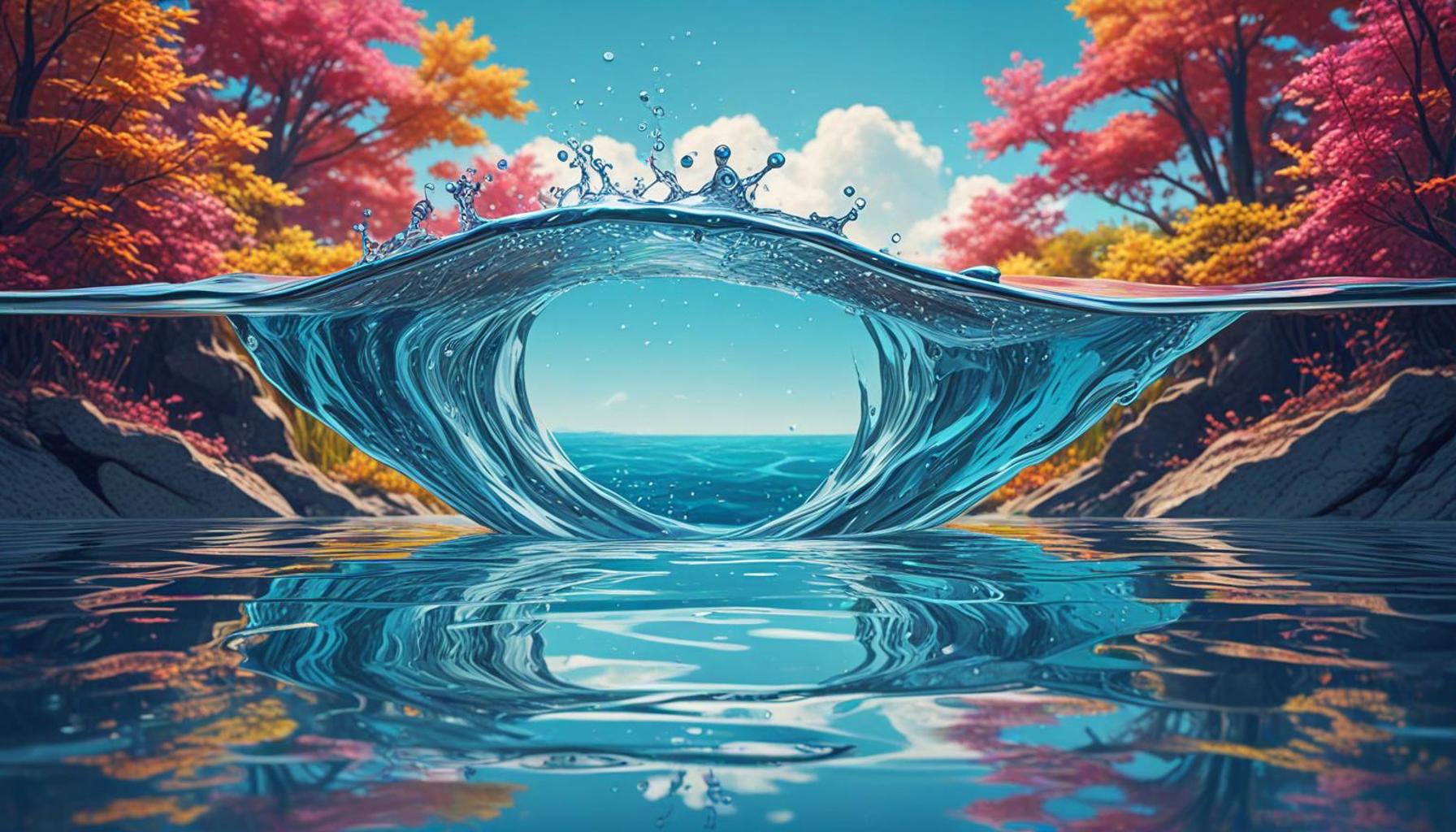Water and Sounds: Creating a Meditation Environment with Water Therapy and Relaxing Music

Finding Peace Through Water and Sound
In today’s fast-paced world, stress can overwhelm even the most resilient individuals. This is where water therapy and relaxing music come into play, offering an escape into tranquility. By merging these elements, one can create a serene meditation environment, perfect for relaxation and mindfulness.
Why Combine Water and Sounds?
Both water and sound have unique properties that enhance meditation. Consider the following benefits:
- Water’s Calming Effect: The gentle flow of water creates a natural white noise that soothes the mind. The sound of water has been shown to lower heart rates and reduce levels of the stress hormone cortisol. In settings such as the tropical rainforests of Nigeria, the symphony of flowing rivers can echo this calming effect, inviting one to pause and reflect.
- Music’s Emotional Connection: Melodic tunes can evoke feelings of peace and contentment. Genres like traditional Nigerian folk music, characterized by soothing rhythms and harmonious vocals, can enhance the spirit that water embodies. As you listen to the gentle resonance of an acoustic guitar or the soothing melodies of your local cultural music, the experience can deepen your emotional health and enhance overall well-being.
- Enhanced Focus: Together, they help in achieving a deeper meditative state. Studies have suggested that multi-sensory experiences, such as those combining water and sound, can significantly improve concentration and mental clarity. Incorporating sounds of bubbling streams with soft instrumental music can heighten one’s ability to focus during meditation.
In Nigeria, traditional practices often incorporate natural sounds and water into ceremonies. Rivers and streams symbolize renewal, while drumming or choral music adds rhythm to spiritual gatherings. A local festival may feature the sound of water splashing against rocks harmonizing with the beats of talking drums, creating an atmosphere ripe for introspection and connection with nature. This blend can be adapted for personal relaxation routines by creating playlists or immersing oneself in local sounds, allowing each person to harness their unique environment.
Creating Your Oasis
Designing your own sanctuary involves simple yet impactful steps. Begin by identifying a space where water features, like fountains or bowls, can be incorporated. Even a small, decorative basin filled with water can work wonders. Pair this with a selection of calming music or nature sounds, such as birds chirping or the rustling of leaves, which can be found in many playlists online. You might even opt for local soundscapes that connect you more with your surroundings.
The goal is to cultivate an ambiance that invites peace and reflection. Use aroma diffusers with essential oils known for their calming effects, such as lavender or sandalwood, to add to your experience. This blend of sensory elements can lead to an even deeper sense of tranquility.

Explore the art of water therapy and sound as a means for achieving true relaxation. Delve deeper into how these elements work together to transform your mental landscape, allowing for moments of serenity amid the busyness of life. The path to inner calm can be navigated with the right tools, and the combination of water and sound can be a powerful ally in this journey.
CHECK OUT: Click here to explore more
The Science Behind Water and Sound Harmonization
Understanding the synergy between water therapy and relaxing music necessitates a deeper dive into their psychological and physiological impacts. The fluid motion of water, paired with melodious sounds, can alter our mental state, facilitating relaxation and enhancing mindfulness. This science is rooted in both ancient practices and modern research, revealing how effectively these elements can foster tranquility in our chaotic lives.
The Therapeutic Effects of Water
Water has long been regarded as a purifying and healing element in various cultures, including those in Nigeria. The soothing sound of rain, a common occurrence in places like Lagos, creates a refreshing atmosphere that has been shown to promote relaxation. Studies indicate that sounds of flowing water can significantly reduce anxiety levels, inducing a sense of calm. The natural white noise generated by water can mask disruptive noises, providing a serene backdrop that allows the mind to settle. The ripple of a stream or the gentle patter of raindrops can transport us to a mental oasis, much like how the waters of the River Niger awaken our senses when we stand near its banks.
Exploring the Role of Music in Meditation
On the other hand, music serves as a powerful tool for emotional connection and cognitive enhancement. Different genres can elicit distinct emotional responses, making it essential to curate the right soundtrack for meditation. In Nigerian culture, the calming tones of traditional instruments such as the kora or shekere can elevate the meditative experience. The intrinsic rhythms and melodies not only soothe the mind but also resonate with our cultural heritage, promoting a familiar sense of belonging.
Integrating music into a water-focused meditation environment can yield profound effects. Here are some reasons why:
- Enhanced Relaxation: Soft melodies can slow the heart rate, complementing water’s natural calming properties.
- Emotional Release: Music encourages emotional reflection, allowing individuals to connect with their innermost thoughts and feelings.
- Improved Meditation Depth: Combining rhythmic water sounds with gentle music fosters a deeper meditative state, enabling users to tap into clarity and insight.
By consciously selecting music that harmonizes with the sound of water, practitioners can significantly amplify the benefits of their meditation. The playful sound of waves crashing along the shore mixed with light instrumental pieces can evoke a sense of peace reminiscent of a day spent by the beach in Lekki. This practice doesn’t merely soothe; it rejuvenates, inviting a rejuvenating flow within both the body and spirit.
As we delve further into creating a meditation environment, it is crucial to consider how individual preferences and local resources can shape this experience. Each person’s journey is distinct, intertwined with their culture and experiences. Combining the elements of water therapy and relaxing music provides a customizable path to tranquility, enabling everyone to forge their personal oasis for reflection and peace.
As the world increasingly recognizes the importance of mental well-being, creating a meditation environment using water therapy and relaxing music is becoming essential. Integrating elements of nature indoors, like the sound of flowing water or soft instrumental melodies, can transport individuals into a tranquil state that fosters mindfulness and relaxation. Studies indicate that such an environment can significantly reduce stress, lower heart rates, and enhance feelings of peace. Furthermore, water therapy, whether through gentle water features or immersion, complements the soothing effects of music, making it easier to let go of daily stresses and anxieties.
Incorporating water sounds into meditation practices can enhance focus and assist individuals in achieving deeper meditative states. The sound of rain, a babbling brook, or ocean waves serves not only as a backdrop but also as a means to ground oneself in the present moment. Similarly, combining these sounds with the right music can create a harmonious atmosphere that promotes relaxation and mental clarity. The choices of instrumental, ambient, or even certain genres like jazz are particularly effective in supporting meditation and enhancing overall experience.
Utilizing technology, one can easily access numerous soundscapes and playlists tailored for meditation. Whether it’s through specialized apps or streaming services, the options are vast and varied, ensuring that anyone can find the perfect auditory backdrop to aid their practice. This blend of natural and musical elements plays a vital role in stress management, helping individuals reclaim their peace of mind in today’s fast-paced world.
| Category | Advantages |
|---|---|
| Relaxation | Water therapy and soothing music create a calming atmosphere that promotes relaxation. |
| Mental Clarity | The combination of water sounds and music aids in achieving deeper states of meditation and mental clarity. |
ADDITIONAL INSIGHTS: Expand your understanding here
Creating Your Personalized Meditation Sanctuary
Designing a meditation space that beautifully melds water therapy and relaxing music requires thoughtful consideration of the senses. A well-crafted environment not only enhances the direct benefits of both elements but also sets the stage for a transformative experience. In Nigeria, tapping into local traditions and resources can elevate this sanctuary into something truly special.
Utilizing Natural Elements
The use of natural elements within your meditation environment is crucial. Incorporating water features such as indoor fountains or small tubs filled with water not only generates the soothing sounds of trickling water but also adds visual tranquility. For a communal feel, think about creating an oasis in a garden or courtyard. The gentle splash of water combined with local flora creates a serene atmosphere reminiscent of the iconic Osun-Osogbo sacred grove. Such settings serve as a reminder of the connection between nature and inner peace.
Incorporating elements like rocks or stones can further create an earthy vibe, anchoring the space and giving it a sense of permanence. These materials resonate well with both water and sound, enhancing the overall sensory experience. The harmony of natural textures coupled with sound can become conducive to long, deep meditations.
Selecting the Right Soundtrack
Choosing the right relaxing music is essential for achieving a meditative state. Look for soundtracks that feature gentle instrumentations, such as the pipes of traditional African music, harmoniously combined with sounds of water. The use of local artists can root your practice in community and culture, further enriching the experience. Creating playlists that include ambient soundscapes, nature sounds, and traditional rhythms can provide an eclectic yet cohesive auditory landscape.
Additionally, consider experimenting with the timing and volume of your chosen soundtrack. Soft background music allows the natural sounds of water to come to the forefront, creating an intricate layering effect. Pay attention to how different playlists impact your mood and sensitivity to stress; small adjustments can lead to profound changes in emotional state.
The Significance of Routine
Establishing a consistent routine is an often-overlooked yet significant part of the meditation process. Allocating a specific time for meditation each day can reinforce the practice, making it easier to find that sacred space of calm amidst the daily bustle. You may find that meditating by the sound of rain during the morning can serve as an invigorating start to the day, while meditative sessions interspersed with the sounds of a bubbling brook can help in winding down. In Nigerian lifestyle, with its busy market scenes and buzzing city life, these moments of mindfulness become essential.
Moreover, by regularly engaging with your meditation environment, you’re forging a bond that deepens your relaxation experience. Consider inviting friends and family to join, reinforcing social connections while simultaneously enhancing personal tranquility. Sharing these moments fosters community and understanding around the importance of personal well-being.
Ultimately, the journey into creating a meditation environment intertwining water therapy and relaxing music is deeply personal. Allow your unique preferences and cultural influences to inspire your practices, leading to a sanctuary that resonates with peace and reflection.
YOU MAY ALSO LIKE: Read read another article
Embracing Serenity with Water and Sound
In conclusion, the harmonious integration of water therapy and relaxing music creates a unique meditation environment that fosters tranquility and inner peace. By utilizing natural elements, you can evoke a sense of calm that resonates deeply with your surroundings—whether it’s the gentle trickle of water from a fountain or the soft rustle of leaves in a garden. These sensory experiences provide a sanctuary away from the hustle and bustle of daily life, especially within the vibrant context of Nigeria’s dynamic landscape.
Furthermore, selecting the right soundtrack is vital. By incorporating local music traditions or ambient sounds that complement water, you can cultivate a more profound connection to your cultural roots while enhancing your meditative practice. An eclectic mix of sounds will allow you to explore different emotional states, depending on the time of day and your specific needs, making each meditation session a new journey of self-discovery.
Your meditation routine should reflect personal preferences, intimately tying together water and sound in a way that resonates with your spirit. By inviting friends or family into this practice, you strengthen community bonds while promoting collective well-being. These shared experiences highlight the importance of mindfulness in an increasingly hectic world.
Ultimately, your meditation sanctuary is an evolving space that reflects your individuality and cultural richness. As you explore different combinations of water and sound, you embark on a transformative journey that not only nurtures your mental health but enriches your life. Embrace the serenity that comes from creating this unique environment, and allow it to lead you to lasting peace and fulfillment.


